A RISKY DESCENT
Surveyor 5 was the first of the project to be assigned to an eastern portion of the Apollo zone. The target was a 60-km-diameter circle in the southwestern region of Mare Tranquillitatis, centred 80 km east of Sabine. The highlands to the west were characterised by prominent southeast-tending ridges and valleys that formed part of the Imbrium sculpture. The target was about 70 km north of the southern boundary of the mare, and 38 km northwest of Moltke. It was also 60 km southwest of where Ranger 8 struck. There were no mare ridges in the immediate vicinity, but the area was crossed by faint rays from Theophilus 350 km to the south. In fact, owing to the magnitude of the gravity turn required to cancel the approach angle relative to local vertical, this site was about as far east as a Surveyor was capable of venturing.
Launch from Pad 36B was at 07:57:01 GMT on 8 September 1967. The Centaur fired for 320 seconds and achieved parking orbit at 08:06:48. It emerged from the Earth’s shadow about 10 seconds later. After coasting for 6.7 minutes, it reignited for the 113-second translunar injection. The spacecraft was released at 08:16:27 and established its cruise mode without incident.
The fact that the initial trajectory would reach the Moon just 46 km from the aim point made this the best performance to date for an American launch vehicle sending a payload towards the Moon. At 01:32:57 on 9 September the spacecraft began to manoeuvre to the attitude for the minor midcourse burn, and at 01:42:28 the squib was fired to open the helium regulator’s valve to increase the six propellant tanks of the vernier propulsion system from their initial pressure of 264 psi to their operating pressure of 720 psi. Immediately beforehand, the helium tank pressure was stable at 5,160 psi. The decrease in helium pressure due to pressurising the propellant tanks was 182 psi, as expected. The burn was initiated at 01:45:02. It lasted 14.25 seconds, and the 45.5-ft/sec change refined the trajectory as desired. As the spacecraft was in the process of re-establishing its cruise attitude, the engineers checking the telemetry were alarmed to observe that instead of holding at 720 psi, the propellant pressure
was rising. It was conjectured that a particle of contaminant had lodged in the seat of the helium regulator and was preventing the valve from closing properly.
There was nominally a 1-hour time constraint between vernier firings, but in view of the need for haste this was waived. Additional firings were made in unsuccessful attempts to clear the valve. As there were bladders in the propellant tanks, there was no mixing of helium and propellant, and whenever the pressure reached 825 psia a relief valve opened to vent the excess pressurant to space. As a result, the helium tank was losing pressure at a rate of about 10 psi per minute. This promised disaster when the vehicle attempted its descent to the Moon, as the verniers would fizzle out from propellant starvation far above the lunar surface.
The first impromptu vernier firing was made with the vehicle’s main axis pointing at the Sun, because the vehicle had already re-established that attitude. The burn was made at 02:12:03, some 27 minutes after the midcourse manoeuvre. It lasted for 10.1 seconds and the change in velocity of 32.1 ft/sec had the effect of driving the aim point 1,600 km along the equator to longitude 77.5°E. This was only a temporary digression, however, because the vehicle was then yawed through 180 degrees and a second burn was initiated at 02:39:51. This lasted 23.0 seconds and the change in velocity of 73.9 ft/sec drove the aim point 2,685 km westward, to longitude 12°W. For these burns the pre-ignition temperatures exceeded the engines’ operating limit, but they fired satisfactorily. Unfortunately, the helium regulator continued to leak.
After a period of deliberation, it was decided to make a third impromptu burn. In addition to a ‘critical component’ of 27.2 ft/sec to re-establish the aim point, there was a non-critical component of 36.1 ft/sec designed both to increase the flight time and to burn off propellant in order to reduce mass and thereby the velocity at retro burnout. To further improve the chances of clearing the regulator valve, the required 13-second duration would be built up by firing the engines for 12 seconds and then twice pausing for 1 second and ‘blipping’ them for half a second. This sequence was started at 04:18:48 and imparted a change in velocity of 45.3 ft/sec, but did not clear the valve.
At 05:50 one team of engineers was assigned to work out a manoeuvre that would enable Surveyor 5 to avoid the Moon and remain in an Earth orbit possessing a high apogee, in case it was decided to abandon the Moon as the target. Meanwhile, other engineers calculated that if sufficient propellant could be burned off to lighten the vehicle and thus reduce the velocity at retro burnout, and if retro ignition were to be postponed to a much lower altitude, then it might be possible to achieve a landing despite the helium problem. At 07:43 it was decided to attempt to accomplish the lunar mission.
The fourth impromptu vernier firing was to burn off propellant in order to further reduce the retro burnout velocity and increase the volume available in the propellant tanks for the helium leaking from the regulator. The latter would both minimise the rate of venting and maximise the impulse available for operating the engines in the vernier descent. The burn was initiated at 08:24:03, lasted 33.0 seconds, changed the velocity by 106.0 ft/sec, and drove the aim point into the central highlands. For the next 13 hours the spacecraft was tracked to precisely define its trajectory. Given the uncertainty about whether a soft-landing would be achieved, it was decided to test the alpha-scattering instrument to check its calibration and assess whether there was a significant cosmic background. Power was applied to the instrument at 10:36. The calibration rates transmitted by an omni-directional antenna were monitored for two 10-minute periods by the Deep Space Network station at Canberra in Australia, then the instrument was switched off at 11:25. The fact that the background was very low was good news; if this should prove to be the only scientific data from the mission, it would assist with the next one. The fifth and final impromptu burn had a critical component of 12.7 ft/sec to draw the trajectory 267 km back towards the target, and a non-critical component of 11.8 ft/sec to further reduce the retro burnout velocity and increase the gas volume in the propellant tanks. ft was made at 23:30:58, lasted 5.45 seconds and imparted a change in velocity of 17.3 ft/sec that returned the aim point to within 30 km of the target. By 23:46:37 the spacecraft had re-established its cruise attitude. The midcourse manoeuvre itself had used 11.3 pounds of propellant, and the impromptu firings had consumed another 67 pounds.
A new descent profile had been devised to minimise the total impulse requirement for the verniers, to enable them to accomplish the landing by operating solely on the residual helium pressurant. On a normal descent the altitude of retro burnout was selected to allow ample time for the verniers to initiate the gravity turn in advance of reaching the ‘descent contour’, but now this margin had to be minimised to reduce the duration of the vernier-only phase of the descent.
The altitude marking radar would still issue its mark at a slant range of 100 km, but the programmed delay would be increased to 12.325 seconds in order to reduce the altitude at which to initiate braking. fn the case of Surveyor 1, whose target was at 43°W, the approach angle had been at 6.1 degrees to the local vertical; for Surveyor 3, at 23°W, the angle was 23.6 degrees; for Surveyor 4, on the meridian, it was 31.5 degrees; for Surveyor 5, aiming for 23°E, the angle would be 46.5 degrees – even on the original plan, this was to have been the most demanding descent to date. fnstead of aligning the thrust axis precisely with the velocity vector, it had been decided to offset it by 0.78 degree in order to enable a component of the powerful retro-rocket’s thrust to contribute to reducing the approach angle, and thereby reduce the gravity turn the verniers would have to perform. And to ensure the most accurate alignment of the retro axis the pre-retro roll was timed for when the divergence in the Canopus sensor would be zero, and the yaw for when the Sun would be precisely aligned in that sensor – as calculated by monitoring the oscillations in the alignment. Whilst the pre-retro sequence in which the vehicle departed from its cruise attitude would usually include a roll to optimise post-landing operations, for this descent the only factor considered was the RADVS, and because the first roll would satisfy this requirement the second roll was deleted. fn essence, therefore, the powered descent would be initiated later than usual in order that instead of retro burnout occurring at an altitude of 35,000 feet this would take place at 4,260 feet, and instead of the total velocity being 400-500 ft/ sec it would be just 100 ft/sec. fn addition, the release of the spent retro-rocket casing was revised to advance the onset of RADVS-controlled flight by 4 seconds – since this time every second would count! These changes were designed to make the most efficient use of the remaining helium pressurant, but the descent would be much more risky than the usual profile.
VELOCITY, FEET PER SECOND
The helium pressurant problem suffered by Surveyor 5 required the burnout of its retro – rocket to occur at an unprecedented low altitude. Note that the 99% dispersion ellipse for retro burnout extends below ground level!
The pre-retro roll of +73.8 degrees was started at 00:12:15 on 11 September, and the yaw of +119.6 degrees at 00:16:20. The altitude marking radar was enabled at 00:43:01 and issued its 100-km slant-range mark at 00:44:39.118, at which time the vehicle was travelling at 8,441 ft/sec. During the specified delay of 12.325 seconds it would travel 104,000 feet, and, in view of the angle of the trajectory, the altitude would reduce by some 74,000 feet prior to retro ignition – this delay being to fly the revised powered descent profile.
The verniers ignited at 00:44:51.443, and the retro-rocket at 00:44:52.533. The helium pressure at vernier ignition was 836 psia, which was sufficient to provide the desired total vernier thrust of 152 pounds for this phase of the descent. The RADVS was switched on at 00:44:53.456, and the radar altimeter locked on at a slant range of 16,000 feet. The acceleration switch noted the peak thrust of 9,740 pounds fall to 3,500 pounds at 00:45:31.355, indicating a burn duration of 39 seconds. The spent casing was jettisoned at 00:45:40.395. The flight control system throttled the three verniers to full thrust at 00:45:40.955 to ensure that the casing fell clear. At burnout, the angle between the thrust vector and velocity vector was 45 degrees.
At 00:45:42.395 control was passed to the RADVS. The altitude was 4,139 feet (a slant range of 6,300 feet owing to the approach angle) and the velocity was 79 ft/sec (the vertical component of which was 46 ft/sec). Attitude control was switched from inertial to radar, and the vehicle immediately resumed the gravity turn by holding a constant deceleration of 0.9 lunar gravity whilst maintaining the thrust in line with the instantaneous velocity vector. At 00:46:19.697 the radar indicated the 1,000-foot mark. On a normal descent, the vehicle would intercept the ‘descent contour’ at a slant range of 18,000 to 25,000 feet, travelling at 400 to 500 ft/sec with 100 seconds remaining to landing. On this revised profile it was to have reached the contour at a slant range of 1,500 feet, but it did so at 806 feet with just 22 seconds remaining for the closed-loop throttling phase. The 10-ft/sec mark was issued at 00:46:37.097, at a height of 50 feet. Some 5.6 seconds later, at 00:46:42.697, the verniers were cut off with a sink rate of 5.2 m/s, and Surveyor 5 fell freely for 1.7 seconds.
After leg no. 1 hit the surface at a vertical rate of 13.5 ft/sec, the vehicle pitched over at an angular rate which was faster than the gyroscopes were able to measure, and 190 milliseconds after first contact the other legs slammed down at 13.8 ft/sec and it came to rest tilted at 19.5 degrees. It was the harshest landing of the project to date, but still within the design specification. Fortunately, the lateral velocity component was negligible and the widely splayed legs prevented the lander from toppling over.
The time spent under RADVS control was a mere 62 seconds. The descent had burned 60 pounds of propellant – a little less than was consumed by the impromptu firings after the midcourse manoeuvre. Although about 45 pounds remained, the issue had not been a shortage of propellant; it was a shortage of helium pressurant to force the propellants into the engines, and by the end of the descent the helium, fuel and oxidiser pressures were identical at 560 psia – in effect, the vernier propulsion system had been in ‘blow down’ mode. Some engineers had estimated the likelihood of achieving a soft-landing at no better than 40 per cent, so this success came as a great relief! The engineering recommendation was to improve quality control in the
The descent of the Surveyor 5 spacecraft depicted in two sections, one for slant ranges above 1,000 feet and the other below 1,000 feet. The delayed retro-rocket braking meant the vehicle did not join the contour until the third segment of the linear approximation to the ideal parabolic trajectory.
The history of Surveyor 5’s helium pressurant from launch to lunar touchdown, showing the leak that developed when the valve of the regulator was activated and the stabilisation of the depleted level by the impromptu midcourse manoeuvres.
|
A picture taken by the 36-inch refractor of the Lick Observatory showing the southwestern part of Mare Tranquillitatis assigned to Surveyor 5.
|
manufacture of the helium regulator to eliminate contaminants that could prevent the proper reseating of the valve.
In-flight tracking indicated that it landed some 30 km northwest of the target, at a point that was just off the edge of frame H-78 taken by Lunar Orbiter 5 the previous month – the only high-resolution picture of this particular area – and the best that could be done was to mark a medium-resolution frame with an ellipse based on the post-landing tracking data and give the selenographic coordinates of its centre. The site was either in, or close to, a faint ray from Theophilus.
Surveyor 5 arrived some 35 hours after local sunrise, with the Sun at an elevation of 17 degrees. The first 200-line picture was taken at 02:01, and the entire initial sequence of 18 frames had been transmitted by 02:39. Although it was evident that the lander was on a steep slope, its orientation was uncertain, and this complicated the task of aligning the high-gain antenna. This began to scan the sky at 02:58, with Goldstone monitoring the strength of the received signal and directing the search. Meanwhile, the solar panel locked onto the Sun at 04:10. The antenna finally locked on at 05:21, and the first 600-line picture was transmitted at 05:30.
TV AUXILIARY UNIT.
SIGNAL PROCESSOR,
I TRANSMITTER
THERMAL COMPARTMENTS
The camera provided for Surveyor 5 had a modified hood for the mirror assembly.
It was soon realised that foot pad no. 1 was resting on the southwestern margin of a small irregularly shaped crater 12 metres long by 9 metres wide and a fraction over 1 metre deep, and the other legs were inside the cavity. The crater was rimless, with the slope increasing towards the centre, where there was a distinctly concave floor spanning about 2.4 metres. In fact, the crater was of a type which had been classified in the Ranger imagery as a ‘dimple’, and the lack of a rim had led some people to argue that such pits marked where the loose surface material had drained into a subterranean space – with the implication that such features were not of impact origin.1 The major axis of the crater was northwest-southeast, and the vehicle was on the southwestern interior wall, tilting northeast. It seemed to be the largest member of a chain of small elongated craters, all oriented with their major axes in line with the chain, and there were other chains in the area sharing this directionality.
Pad no. 1 had struck just outside the crater, and the others on its interior slope. As the vehicle rebounded, it slid downslope, causing pads no. 2 and 3 to scrape furrows about 1 metre long before they came to rest near the base of the wall. So, although this lander did not possess a soil mechanics surface sampler with which to scrape a trench, its legs served this role. As the vehicle slid down into the crater, pad no. 1 was dragged closer to the edge and the fragmental material that it displaced came to rest directly beneath the camera. Furthermore, as pads no. 2 and 3 ploughed their furrows they hinged and drove their outer edges into the surface, causing material to spill onto their upper surfaces where it was conveniently situated for examination by the camera. The furrows varied in depth between a few centimetres and 12 cm, most likely because the slide coincided with the rebounding of the legs following the initial impact. Furthermore, in addition to piling up material downslope, pads no. 2 and 3 splattered ejecta for a distance of about 1 metre across the concave floor – in fact, this was the greatest displacement of lunar material of any landing to date. The cohesion of the aggregates was evident from the fact that one clod remained intact on settling on the floor of the crater. The frequency-size distribution of the lumpy fragmental material pushed downslope was much coarser than that on the undisturbed surface.
The walls of the crater in which Surveyor 5 landed provided a view into the upper half-metre of the fragmental debris layer. There were bright angular fragments that seemed to be rocks, rounded aggregates of fine-grained material with bright angular chips bound into a dark matrix, and dark lumpy aggregates of aggregates. Beneath a depth of 10 cm it appeared to be a uniform mass of fine-grained material containing small rocks and shock-compressed aggregates several centimetres in size. Although the albedo of the disturbed material was comparable to that at the previous sites, the undisturbed surface was less bright, making the difference less pronounced. The flat mirrors which had been installed on leg no. 1 of Surveyor 3 had been superseded by convex mirrors to improve the view beneath the lander. Material around the bottom
The ‘dimple’ craters are now known to be secondaries made by the fall of ejecta issued by larger impacts.
A detailed map of the small crater in which Surveyor 5 landed and the immediately surrounding plain, produced by R. M. Batson, R. Jordan and K. B. Larson of the US Geological Survey.
edge of crushable block no. 3 implied that it struck the surface at the time of landing, but any imprint had been masked by the material thrown forward by pad no. 1 when this was dragged towards the crater as the other legs slid down the interior slope.
As the mirror of the camera was only 1.2 metres above the plane of the foot pads and was between legs no. 2 and 3, it too was ‘inside’ the crater, with the result that more than 80 per cent of the field of view was within a range of 6 metres. The view of the peripheral terrain was highly foreshortened. In fact, although the mirror was
about 80 cm above the northern rim, the fact that the rim was higher to the southeast meant that the mirror was only 30 cm above the southern rim. For a lander on open ground the horizon would have been 2 km away. In this case, the camera was able to see to a distance of about 1 km to the north and west, but less far to the south and east. In one sector to the south the horizon was barely 100 metres away because it was the raised rim of a 20-metre-diameter crater. There was a strewn field of blocks associated with this crater that extended almost to the crater in which the lander was situated. When the closest blocks of this field were examined at high resolution they proved to be angular to sub-rounded and less than 50 cm in their longest dimension. Some had a mottled appearance reminiscent of a rock at the Surveyor 1 site. There was another strewn field associated with a 15-metre crater situated 200 metres to the north. On the basis of these strewn fields and other raised-rim craters in the middle distance, it was possible to estimate the fragmental debris layer in this part of Mare Tranquillitatis to be no greater than 5 metres thick.
On Surveyor 5, the soil mechanics surface sampler was replaced by an instrument to study the composition of the lunar surface material. This was developed by a team headed by Anthony L. Turkevich, a nuclear chemist at the University of Chicago. It comprised an electronics package in a thermally controlled compartment which was mounted high on the vehicle’s frame, and a box-shaped sensor head that was stowed midway between legs no. 2 and 3, immediately to the left of where the electronics package for the surface sampler would have been if this were present. Including the ancillary hardware, the mass of the experiment was 13 kg. The head was held by its deployment mechanism until needed, then lowered on a nylon cable to the surface with a ribbon cable linking it to its electronics. The head was about 13 cm tall with a 17 x 16-cm cross section. To prevent the box from sinking into soft material, it had a D-shaped 15-cm-radius plate on its base. Six curium-242 alpha-particle sources inside the head were collimated to irradiate the surface through a 10.8-cm hole at the centre of the base plate. This isotope was chosen for its short (163-day) half-life, to obtain a high emission rate and a narrow energy distribution in the irradiation. A pair of sensors were positioned to detect alpha particles which were scattered back from the surface. There were also four sensors for any protons issued by nuclear reactions resulting from the irradiation of the surface. The instrument would be calibrated by alpha particles emitted by a ‘standard sample’ of einsteinium-254. The instrument was completed in September 1966 and, after acceptance tests, was delivered to Hughes on 18 January 1967 for use on this mission. Although the alphascattering technique could measure the abundances of elements with masses ranging from carbon up to iron, its ability to identify atomic weights at the heavier end of this range relied on achieving a high signal-to-noise ratio in the energy spectrum. The data was to be transmitted to Earth as a sequence of 10-bit words in real-time (although not on a continuous basis since the instrument and the camera could not use the high-gain antenna simultaneously) and stored on magnetic tape for later analysis. The elemental abundances would yield no direct information of how the elements were combined as chemical compounds, nor of how these compounds were combined as minerals – such insight would have to be inferred from assumptions about the nature of the sample.
|
A strewn field of blocks nearby Surveyor 5 to the south.
|
Alpha-scattering instrument and auxiliary hardware. The sensor head is the part of the instrument which was lowered to the lunar surface. In its stowed position, the head was held on the deployment mechanism in contact with the standard sample. The digital electronics and auxiliary electronics were housed in thermal compartment ‘C’.
.J
LUNAR SURFACE
The operation of the alpha-scattering instrument’s deployment mechanism.
The operating procedure was designed to obtain, in turn: data on the performance of the sensor with the head in its stowed position; the background radiation in the lunar environment with the head partially deployed; and the composition of the lunar surface with the head fully deployed. The first stage would be done with the head in its stowed configuration, in which it could view the standard sample. About 2 hours after landing, the instrument was checked out. Power was applied at 02:50 and the system interrogated, then it was switched off at 04:40. Following the handover from Goldstone to Canberra, the camera surveyed the area where the head would deploy, both directly and by using an auxiliary mirror affixed to leg no. 1, and revealed that the head would drop onto material which had been dislodged from the wall of the crater by the vehicle’s arrival. Although mainly aggregates of fine-grained material, the sample area was fairly smooth with the largest aggregate about 3 cm in size. The instrument’s beam of alpha particles was capable of penetrating only a few microns, but the aggregates were probably typical of the subsurface, and hence representative of the mare. Ideally, the calibration would be given 6 hours, as would measuring the background. But a complication now arose.
At about 08:00 it was decided that during the second Goldstone session a static firing of the verniers should be performed, before the engines overheated as the Sun continued to rise in the sky. As this left only about 12 hours in which to deploy the alpha-scattering instrument, this had to be abbreviated. Three 20-minute readings of the standard sample proved the detector to be working satisfactorily. It was therefore
|
A view of the underside of the alpha-scattering instrument’s head showing the relative positions of the sources and sensors.
|
decided to remove the standard sample. To save time, the scheduled pictures were cancelled. Instead, Canberra monitored the data in real-time using an oscilloscope, and when the command was sent at 12:14 the rate fell by a factor of ten, confirming that the standard sample had swung clear to expose the aperture in the base plate of the head about 60 cm above the ground. After measuring the background of cosmic rays, solar protons and possible surface radioactivity for 170 minutes, it was decided to proceed with the deployment to obtain some sample data before the vernier firing. The head was to be lowered to the surface by a nylon cord wrapped around a geared cylinder. A pyrotechnic charge released the locking pin, and the cord unreeled under the weight of the head, lowering it in several controlled steps. As previously, the TV coverage was cancelled and real-time monitoring of the data by Madrid confirmed that the head touched down at 15:36. On the surface, the count rate sharply increased – almost to the level of the standard sample. A surface sample would require a total integration time of at least 24 hours – the longer the better, to improve the signal-to-noise ratio. About 5 hours of data had been obtained when Goldstone took over. By then it had been decided to postpone the vernier test by 24 hours, and so Goldstone spent its session photographing the surface in the immediately vicinity
of the lander as a point of reference for the study of erosional effects. The pictures showed that in settling on the slope, the base plate of the head had partially embedded itself on the downslope side. The instrument renewed integrating at 06:18 on 12 September, via Canberra. Twelve hours of data was accumulated over the next 17 hours, and then the instrument was switched off. A total of 18.3 hours of data had been obtained for the surface sample.
|
A view of the head of Surveyor 5’s alpha-scattering instrument on the lunar surface.
|
After the verniers were fired at 05:38 on 13 September, Goldstone took a second set of pictures. These showed that the engine blast had further embedded the base plate of the head and tilted it sufficiently to raise the near side of the plate 2 cm off the ground. About 3 hours later, the instrument was restarted and established to be still functional. Because the aperture of the plate had been displaced by more than one diameter’s distance, the new data was treated as a second sample. About 9 hours of data had been obtained by the end of that day. The maximum permitted operating temperature of the head was 55°C, and that for the electronics box was 50°C. Only 1 hour of data was obtained on 14 September and the instrument was not used at all on 15 September. But on 16 September the shadow of the high-gain antenna fell on the head and sampling was able to resume. Noon was at 01:47 on 17 September. By the time the final data was taken on 23 September the temperature of the head had fallen to -56°C, which was 16°C below its operating minimum. The next day, the Sun set. In all, 66 hours of data had been obtained for the second sample.
The three most abundant elements found by Surveyor 5 proved to be the same as those which are most prevalent in the Earth’s crust – namely (in decreasing order): oxygen, silicon and aluminium. By the process of gardening, the uppermost layer of material could be expected to be primarily fragments of what lay beneath (although there would be some material tossed in from elsewhere) and hence could reasonably be presumed to be characteristic of the bedrock at that locality. Although the retro – rocket burn was made at a much lower altitude than usual, there was little chance of solid particles of aluminium oxide in the exhaust contaminating the analysis that was later performed by the lander, especially as the sample was not undisturbed surface material.
As a chemist, Harold Urey believed the Moon to be ‘pristine’ material condensed from the solar nebula, and hence of an ultrabasic composition. The alpha-scattering data showed that the analysed material was too poor in magnesium to be ultrabasic, and too rich in iron and calcium to be an acidic rock such as granite. A good match was a basalt created by chemical fractionation of ultrabasic silicates. The similarity in the general character of the three mare sites visited by Surveyors implied that this analysis was probably representative. Superposition relationships of geological units indicated that the ‘circular maria’ were not created at the same time as the basins in which they reside. This ruled out the maria forming by fractionation of a splash of impact melt – they simply had to be volcanic flows. This was clear evidence that the Moon was thermally differentiated and argued in favour of the ‘hot Moon’ theory expounded by Gerard Kuiper.[38]
On Surveyor 5, foot pad no. 2 had two bars mounted on its vertical side in view of the TV camera, one of which was magnetic to assess the presence of material with a high magnetic susceptibility, and the other was non-magnetic to act as the ‘control’ by indicating the extent to which the lunar material would adhere to a metal bar. The magnet was strong enough to attract the ferrimagnetic mineral magnetite – which is common in igneous rocks on Earth, with different types of rock possessing differing percentages of this mineral – and the ferromagnetic metals iron, nickel and cobalt. To expose the magnet to contact, the pad needed to penetrate the surface to a depth of at least 6 cm. Serendipitously, this pad was one of those that scraped a furrow as the vehicle slid into the crater, and the magnet was in direct contact with material for most, if not all, of this time. However, in the orientation in which the lander came to rest, the magnet was in the shadow of the foot pad and could not be inspected until later in the lunar day, when it was revealed to be stained with a small quantity of magnetic material of a grain size finer than the camera’s resolution – which at that range was between 0.5 and 1 mm. After making comparative laboratory tests, it was concluded that the observations were consistent with pulverised basalt in the 40-50- micron size range, with a 10-12 per cent fraction of magnetite and no more than 1 per cent of admixed metallic iron. Because it had been believed there would be an accumulation of meteoritic iron on the surface in the form of dust, this was much less metallic iron than most people had expected.
To follow up the observation that Surveyor 3’s verniers seemed to have disturbed the surface during its ‘hot’ touchdowns, it was decided that Surveyor 5 should fire its verniers for a duration of 0.55 second at a total thrust less than its weight in lunar gravity, in order not to cause it to move. One motivation was that, like Surveyor, an Apollo lander was to cut off its engine a few feet above the surface, and a grounded Surveyor firing its verniers at low thrust would impart a comparable loading on the lunar surface to an Apollo lander in the final part of its descent – so this test would provide information that would enable the Apollo planners to estimate the effects of their lander’s arrival. The specific objective was to determine the type and degree of erosion caused by the interaction of rocket efflux with the surface material, thereby estimating its cohesivity and permeability. Three processes of erosion were possible. Viscous erosion was entrainment of particles as the gas flowed across the surface. Gas diffusion erosion was due to gas penetrating the pores in the surface material while the engine was firing, with an upward force during and after the firing causing the movement of material. Explosive cratering would occur if the pressure of the gas impinging on the surface exceeded the material’s bearing capacity, compressing and excavating it. In the lunar environment, where full expansion of the plume produced by the verniers at low thrust would be possible, explosive cratering was not expected to play a significant role. At its second bounce, Surveyor 3 appeared to have caused some viscous erosion, but because it had lifted off again there was no sudden engine shutdown and hence no opportunity to study diffused gas eruption. The aim of the Surveyor 5 experiment was therefore to investigate the effects of engine shutdown. Prior to the test, the surface in the immediate vicinity of the lander was documented in detail.
At 09:30 on 12 September the flight control system was powered up to verify its status. The temperatures of the components of the vernier propulsion system, and in particular the pre-ignition temperatures of the solenoid-operated propellant valves of the engines, were the dominant factors in deciding when to perform the test. The fact that the vehicle was inside a crater having steep interior slopes affected the heat – rejection capability of the thermally controlled compartments, because the slopes reradiated heat onto the vehicle in a manner that would not have occurred if the lander had been standing on a level surface. Shortly after landing, vernier no. 2 significantly exceeded its pre-ignition temperature limit. It cooled down, but did so only slowly. Meanwhile, with leg no. 1 ‘exposed’ on the rim of the crater, vernier no. 1 progressively rose in temperature. Early on 13 September it was decided to make the test without further delay. At 05:38:05, some 53 hours after arrival, the verniers were ignited at minimum thrust. Despite their high temperatures, the solenoid-operated propellant valves functioned correctly. The engines fired for about 0.57 ( + 0.15) seconds, with vernier no. 1 delivering 22 pounds of thrust, no. 2 delivering 17 pounds and no. 3 delivering 26 pounds. Despite the slope, the vehicle did not slide any further down into the crater. When the shock absorbers had been commanded to lock following landing, the legs on the downslope side had not done so, and their flexure during the vernier firing increased the tilt by 0.2 degree.
Because no pictures could be taken whilst firing the engines, the analysis utilised before-and-after views of the surface. A key source of data was the surface beneath vernier no. 3, both by direct viewing and by the auxiliary mirror on leg no. 1. This suffered two types of erosion. As the engine cut off, the sudden removal of pressure on the surface evidently allowed the gas which had diffused into the surface to erupt and displace material to erode an arcuate depression some 20 cm in diameter and up to 1.3 cm deep directly under the engine, whose nozzle was 13 cm in diameter with its aperture 37 cm off the ground. There was also viscous erosion which removed a 1-cm-thick layer of material out to a radius of 60 cm and had lesser effects out to about 2 metres. Most, if not all, of the small objects in the immediate vicinity were displaced. The largest fragment known to have been displaced was 4.4 cm in size. The permeability suggested that most of the particles in the surface material were in the 2-60-micron size range – which was consistent with an analysis of the imprint left by one of Surveyor 3’s foot pads. The efflux blew away the dust which had adhered to the control strip and brackets of the magnet experiment on pad no. 2, but did not significantly alter the coating on the magnet itself. It also deposited material on the radiator on top of one of the equipment compartments. A clod must have been ejected by the diffused gas erupting from the surface at engine cutoff and followed an almost vertical trajectory, breaking apart on striking the mirrored surface. When the blast hit the vertical sides of the 2.2-kg head of the alpha-scattering instrument, this was driven about 10 cm downslope and rotated 15 degrees. The ability of the finegrained material to adhere to a smooth vertical metal surface was indicated by a stain on the previously highly reflective head.
Sunset was at 10:56 on 24 September. Between 11:02 and 14:28 Surveyor 5 took 37 images to observe the solar corona with the solar disk just below the horizon. The longest exposures of 10 minutes showed coronal streamers out to 6 solar radii from the centre of the disk, and provided the first measurements of the brightness of the corona to a distance of 30 radii. After reporting the temperature for about 115 hours, the lander was ordered into hibernation at 06:37 on 29 September. Since Surveyor 1
|
Lunar surface brightness-temperature profiles from sensors in Surveyor 5’s thermal compartments as the Moon passed through the Earth’s shadow on 18 October 1967.
|
had reported for 48 hours and Surveyor 3 for a mere 2 hours, this monitoring greatly increased the post-sunset data.
Surveyor 5’s camera had suffered none of the problems that impaired Surveyor 3. There was no evidence of dust or vernier efflux on the mirror, and the azimuth and elevation actions worked perfectly. It returned 18,006 pictures of excellent quality in all illuminations, and the 180 mosaics that it produced made the crater in which this vehicle landed the best documented feature on the Moon! To improve the accuracy of its pointing system for celestial observations, a new procedure was used in which the rotational matrix of the camera relative to the frame of the lander was calibrated by taking a set of pictures of fixed reference points. The alpha-scattering instrument also functioned perfectly, and provided just over 83 hours of data for a total of two samples of surface material.
After being allowed to ‘warm up’ for 147 hours after sunrise, Surveyor 5 replied promptly to a command sent at 08:07 on 15 October. As the temperature declined about 12 hours before sunset of the first lunar day, the unlocked shock absorbers had compressed, deflecting leg no. 2 by 4.4 degrees and leg no. 3 by 6.9 degrees, further increasing the tilt of the vehicle. The fact that the shock absorbers reextended at the start of the second lunar day indicated that their relaxation at sunset was not due to a pressure leak but to a decrease in fluid volume owing to the declining temperature. The camera’s electronics had suffered from the cold during the night, but it was able to provide another 1,048 pictures. The alpha-scattering instrument was reactivated for 22 hours, but the low signal-to-noise ratio indicated that it had deteriorated and this data was rejected. On 18 October the Moon passed through the Earth’s shadow. Surveyor 5 reported thermal data but, in spite of its tilt, was unable to view Earth. After sunset on 24 October, the lander monitored the temperatures for 215 hours until it was ordered into hibernation again at 12:15 on 1 November 1967.
To date, Surveyor 1 had provided a view of an open mare plain, Surveyor 3 had inspected the interior of a medium-sized mare crater, and Surveyor 5 had landed in a very small crater on a mare plain. The main conclusion was that Mare Tranquillitatis was generally similar to the sites in Oceanus Procellarum. In fact, perhaps the most significant observation was that the three sites were so similar that it was difficult to tell them apart!











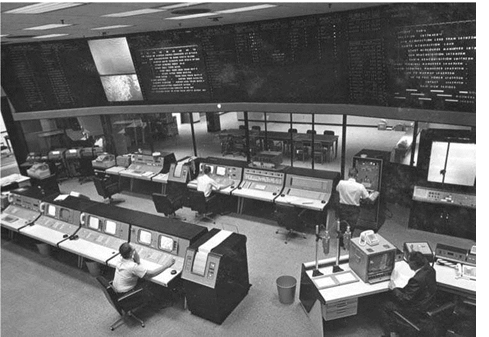
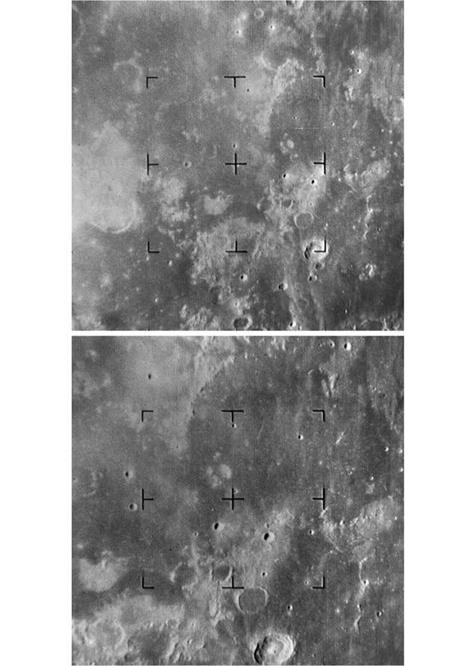
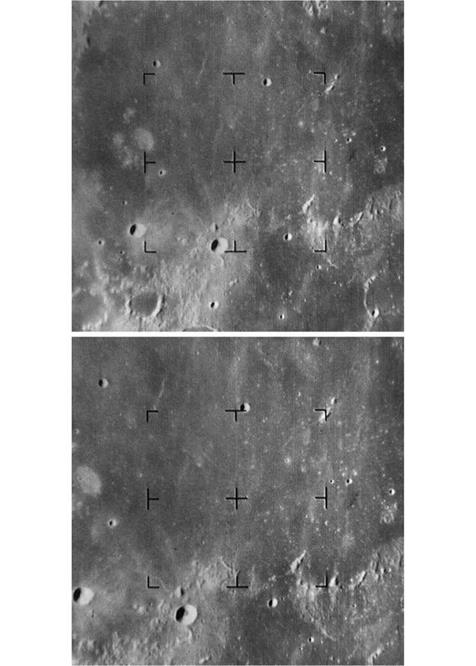
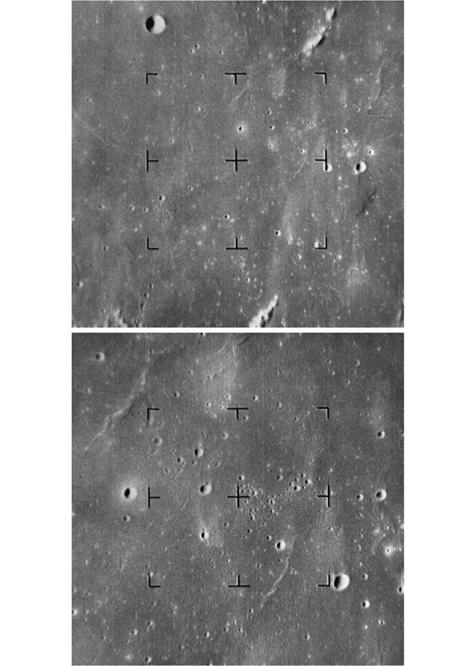
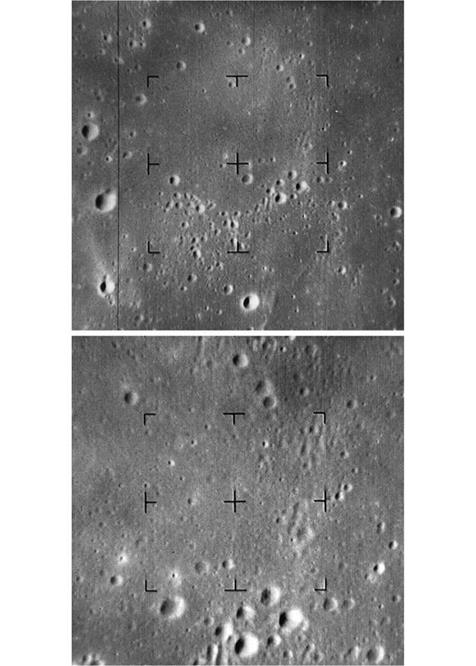
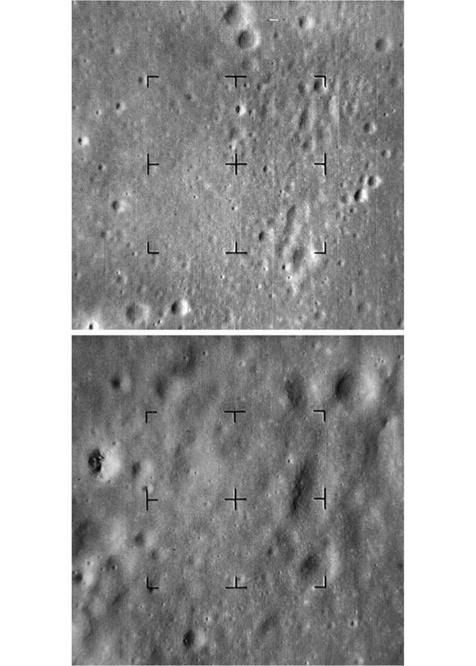
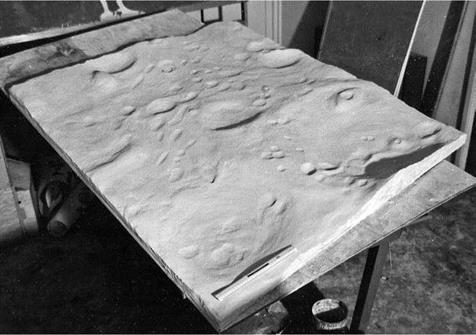
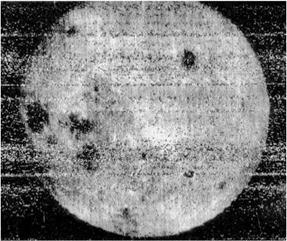 out to emphasise detail. In the wide lens the lunar disk spanned 10 mm, and in the narrow lens it was 25 mm.
out to emphasise detail. In the wide lens the lunar disk spanned 10 mm, and in the narrow lens it was 25 mm.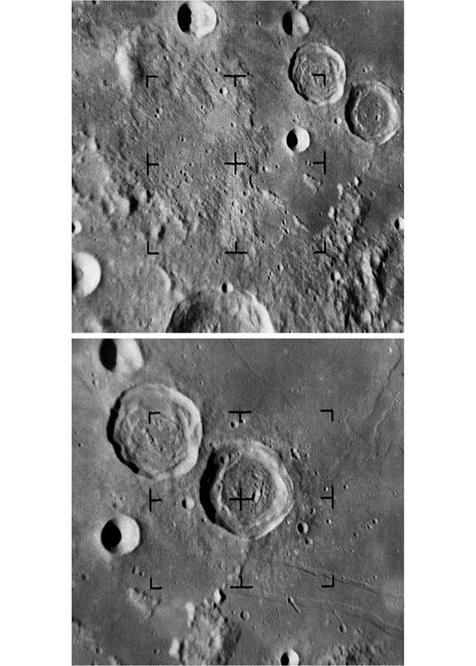
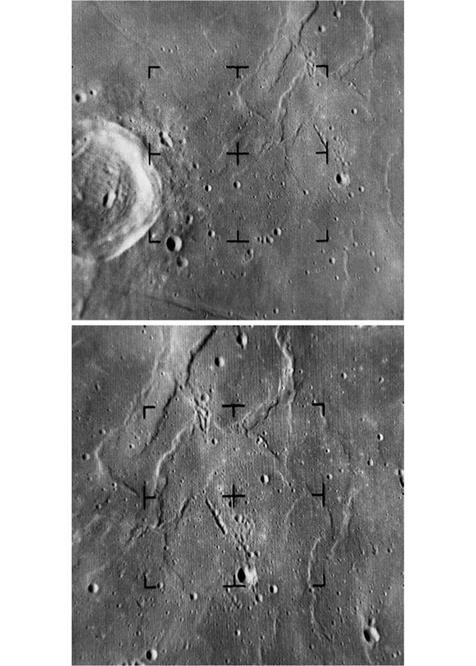
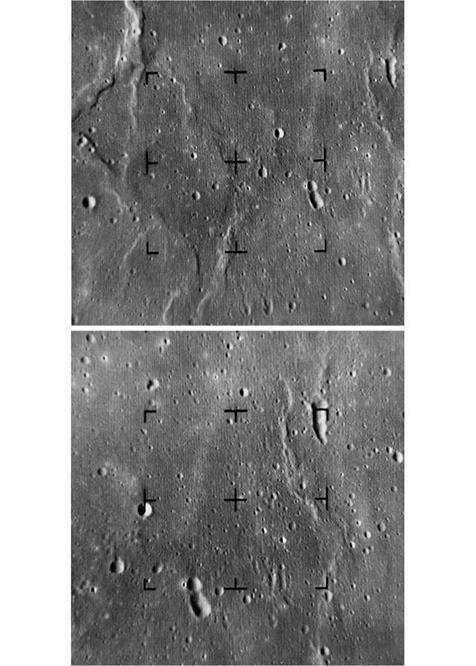
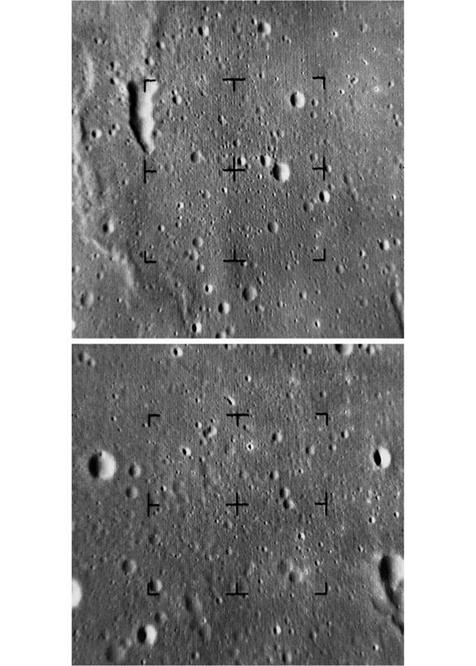

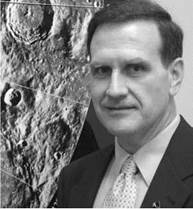 Paul D. Spudis
Paul D. Spudis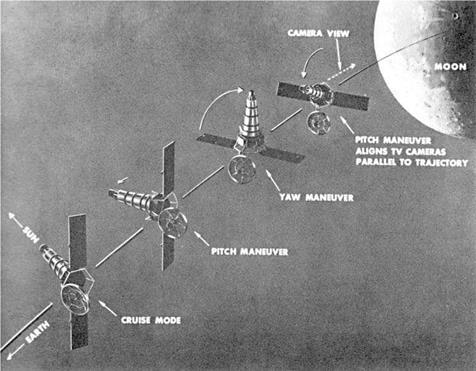
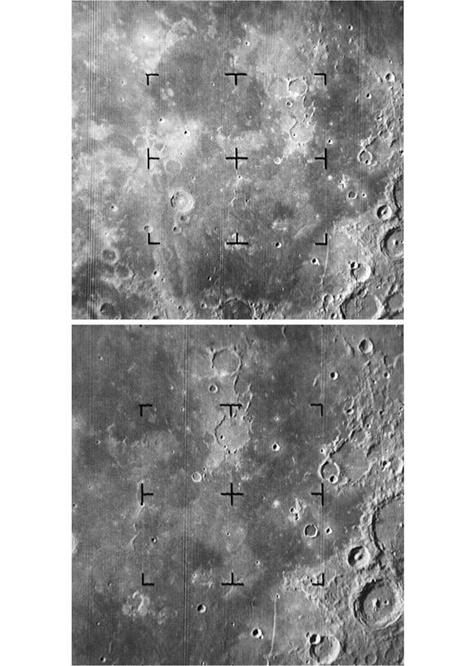
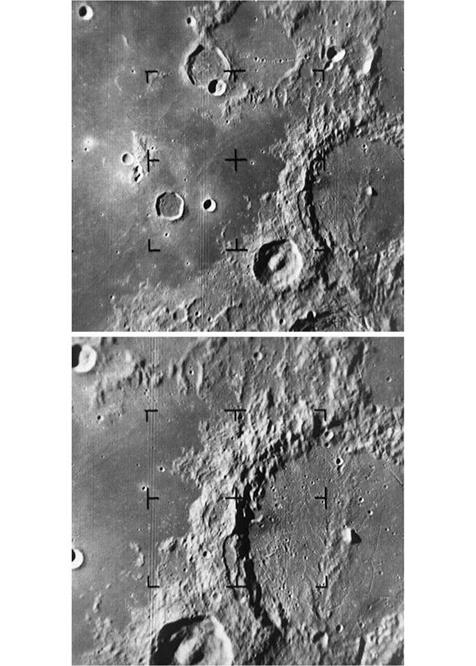
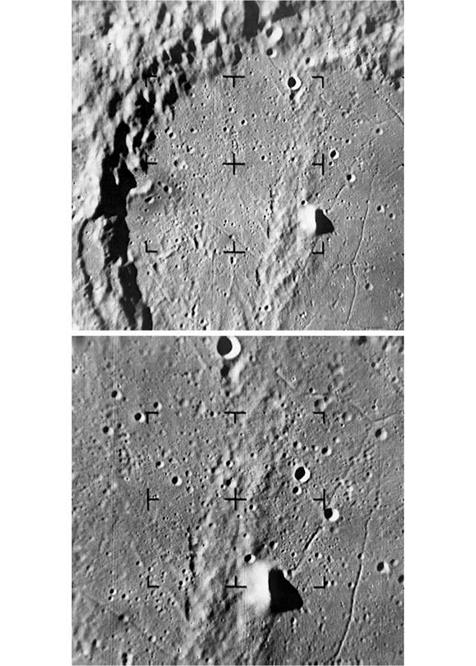
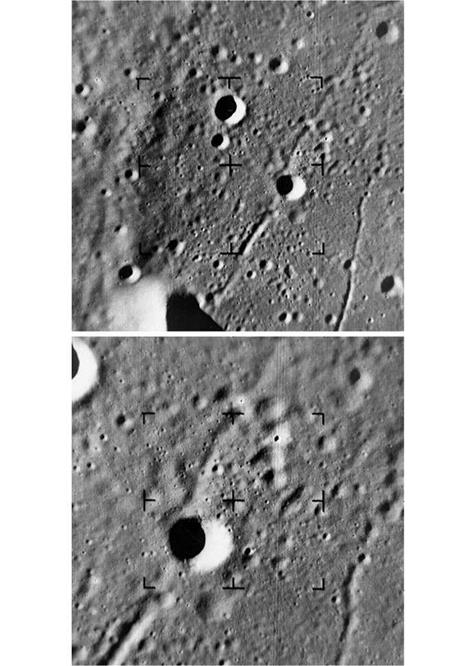
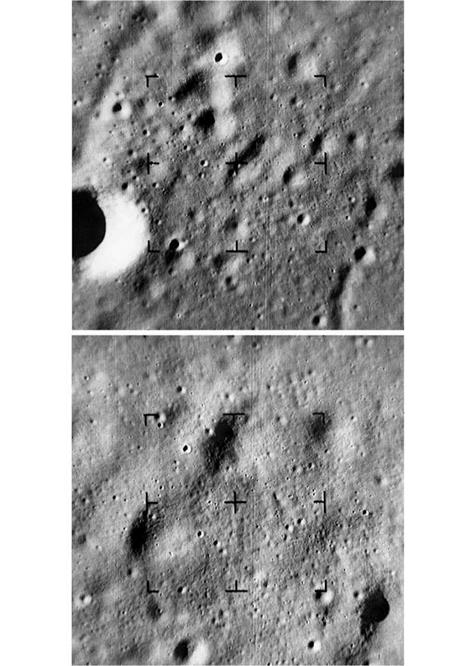
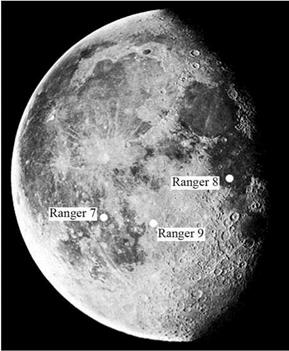 The sites inspected by the successful Ranger missions.
The sites inspected by the successful Ranger missions.